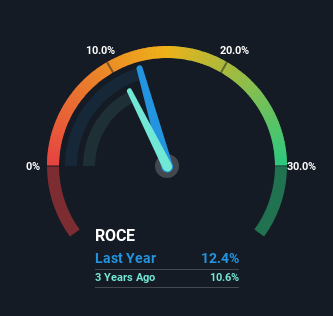- India
- /
- Electric Utilities
- /
- NSEI:POWERGRID
Power Grid Corporation of India (NSE:POWERGRID) Is Looking To Continue Growing Its Returns On Capital

Did you know there are some financial metrics that can provide clues of a potential multi-bagger? Firstly, we'd want to identify a growing return on capital employed (ROCE) and then alongside that, an ever-increasing base of capital employed. If you see this, it typically means it's a company with a great business model and plenty of profitable reinvestment opportunities. So on that note, Power Grid Corporation of India (NSE:POWERGRID) looks quite promising in regards to its trends of return on capital.
Understanding Return On Capital Employed (ROCE)
If you haven't worked with ROCE before, it measures the 'return' (pre-tax profit) a company generates from capital employed in its business. To calculate this metric for Power Grid Corporation of India, this is the formula:
Return on Capital Employed = Earnings Before Interest and Tax (EBIT) ÷ (Total Assets - Current Liabilities)
0.12 = ₹268b ÷ (₹2.5t - ₹344b) (Based on the trailing twelve months to March 2024).
Therefore, Power Grid Corporation of India has an ROCE of 12%. On its own, that's a standard return, however it's much better than the 7.1% generated by the Electric Utilities industry.
See our latest analysis for Power Grid Corporation of India

Above you can see how the current ROCE for Power Grid Corporation of India compares to its prior returns on capital, but there's only so much you can tell from the past. If you'd like, you can check out the forecasts from the analysts covering Power Grid Corporation of India for free.
How Are Returns Trending?
Power Grid Corporation of India's ROCE growth is quite impressive. The figures show that over the last five years, ROCE has grown 32% whilst employing roughly the same amount of capital. So it's likely that the business is now reaping the full benefits of its past investments, since the capital employed hasn't changed considerably. It's worth looking deeper into this though because while it's great that the business is more efficient, it might also mean that going forward the areas to invest internally for the organic growth are lacking.
In Conclusion...
To sum it up, Power Grid Corporation of India is collecting higher returns from the same amount of capital, and that's impressive. And a remarkable 293% total return over the last five years tells us that investors are expecting more good things to come in the future. Therefore, we think it would be worth your time to check if these trends are going to continue.
On a separate note, we've found 2 warning signs for Power Grid Corporation of India you'll probably want to know about.
While Power Grid Corporation of India may not currently earn the highest returns, we've compiled a list of companies that currently earn more than 25% return on equity. Check out this free list here.
New: Manage All Your Stock Portfolios in One Place
We've created the ultimate portfolio companion for stock investors, and it's free.
• Connect an unlimited number of Portfolios and see your total in one currency
• Be alerted to new Warning Signs or Risks via email or mobile
• Track the Fair Value of your stocks
Have feedback on this article? Concerned about the content? Get in touch with us directly. Alternatively, email editorial-team (at) simplywallst.com.
This article by Simply Wall St is general in nature. We provide commentary based on historical data and analyst forecasts only using an unbiased methodology and our articles are not intended to be financial advice. It does not constitute a recommendation to buy or sell any stock, and does not take account of your objectives, or your financial situation. We aim to bring you long-term focused analysis driven by fundamental data. Note that our analysis may not factor in the latest price-sensitive company announcements or qualitative material. Simply Wall St has no position in any stocks mentioned.
About NSEI:POWERGRID
Power Grid Corporation of India
An electric power transmission utility, engages in the transmission of power in India and internationally.
Established dividend payer with mediocre balance sheet.
Market Insights
Community Narratives



